Organisational Behaviour: Leadership, Motivation, and Teams Report
VerifiedAdded on 2020/01/16
|11
|3295
|218
Report
AI Summary
This report examines organisational behaviour, focusing on leadership styles, motivational theories, and team dynamics within City College and Enterprise Rent-A-Car. It explores various leadership styles such as democratic, bureaucratic, autocratic, and transformational, linking them to organisational theories like contingency theory and classical theory. The report analyses the impact of leadership styles on employee behaviour and discusses the application of motivational theories like Herzberg's and Maslow's hierarchies. Furthermore, it delves into the nature of groups and group behaviour, differentiating between formal and informal groups, and identifies factors contributing to effective teamwork, including leadership and group size. The report highlights the role of management in motivation and the use of these theories to achieve organisational goals. It also discusses the role of technology and its impact on team success.
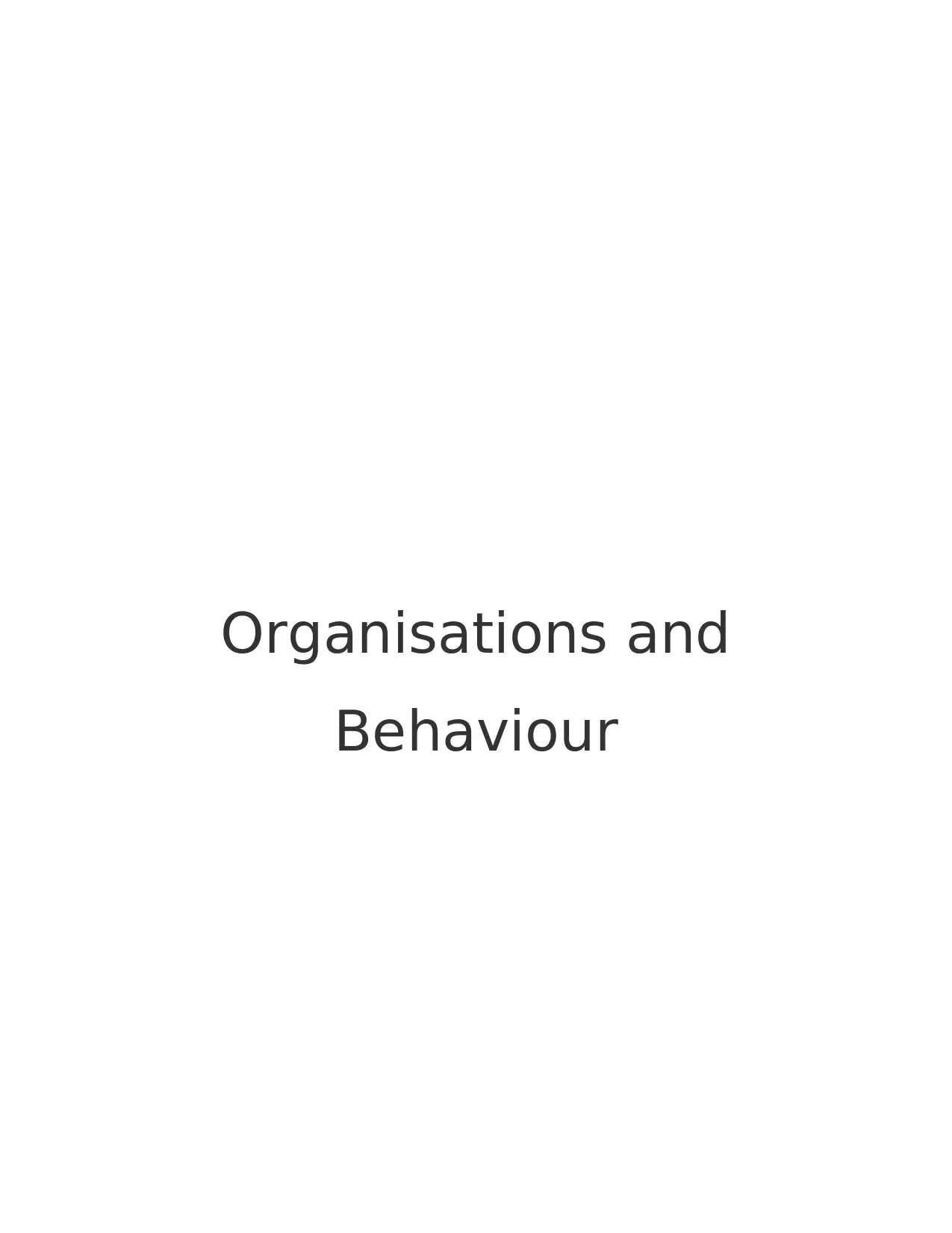
Organisations and
Behaviour
Behaviour
Paraphrase This Document
Need a fresh take? Get an instant paraphrase of this document with our AI Paraphraser
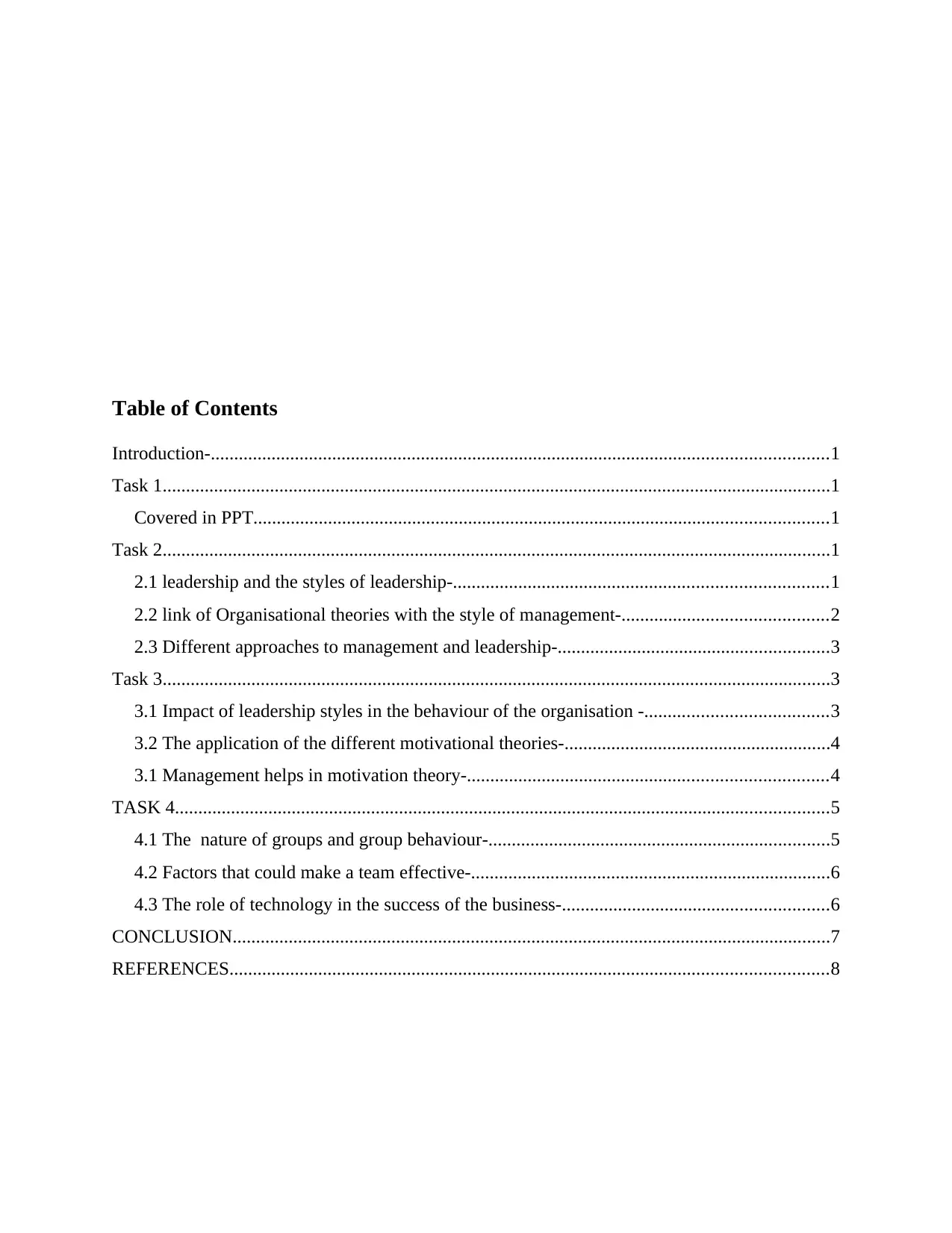
Table of Contents
Introduction-....................................................................................................................................1
Task 1...............................................................................................................................................1
Covered in PPT...........................................................................................................................1
Task 2...............................................................................................................................................1
2.1 leadership and the styles of leadership-................................................................................1
2.2 link of Organisational theories with the style of management-............................................2
2.3 Different approaches to management and leadership-..........................................................3
Task 3...............................................................................................................................................3
3.1 Impact of leadership styles in the behaviour of the organisation -.......................................3
3.2 The application of the different motivational theories-.........................................................4
3.1 Management helps in motivation theory-.............................................................................4
TASK 4............................................................................................................................................5
4.1 The nature of groups and group behaviour-.........................................................................5
4.2 Factors that could make a team effective-.............................................................................6
4.3 The role of technology in the success of the business-.........................................................6
CONCLUSION................................................................................................................................7
REFERENCES................................................................................................................................8
Introduction-....................................................................................................................................1
Task 1...............................................................................................................................................1
Covered in PPT...........................................................................................................................1
Task 2...............................................................................................................................................1
2.1 leadership and the styles of leadership-................................................................................1
2.2 link of Organisational theories with the style of management-............................................2
2.3 Different approaches to management and leadership-..........................................................3
Task 3...............................................................................................................................................3
3.1 Impact of leadership styles in the behaviour of the organisation -.......................................3
3.2 The application of the different motivational theories-.........................................................4
3.1 Management helps in motivation theory-.............................................................................4
TASK 4............................................................................................................................................5
4.1 The nature of groups and group behaviour-.........................................................................5
4.2 Factors that could make a team effective-.............................................................................6
4.3 The role of technology in the success of the business-.........................................................6
CONCLUSION................................................................................................................................7
REFERENCES................................................................................................................................8
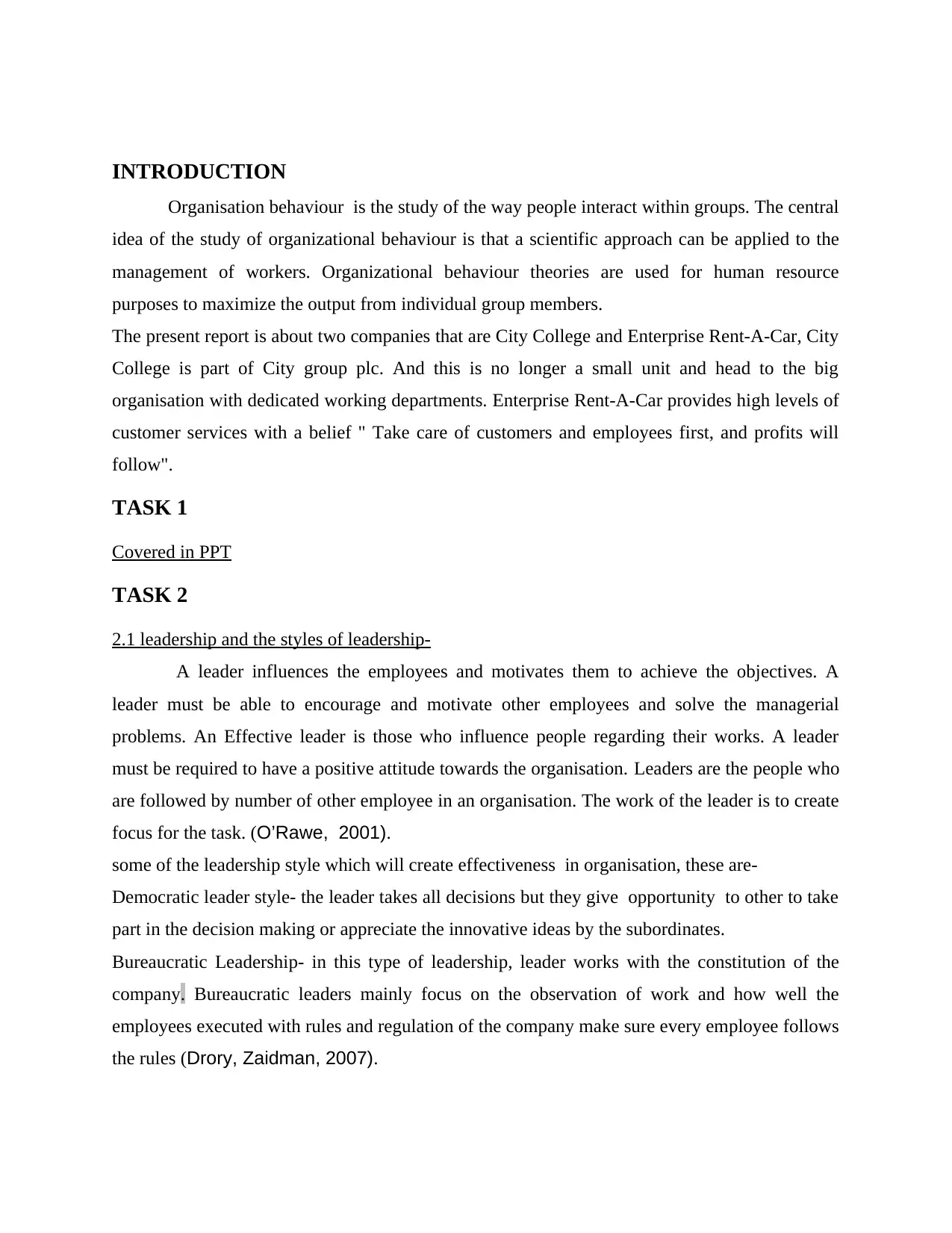
INTRODUCTION
Organisation behaviour is the study of the way people interact within groups. The central
idea of the study of organizational behaviour is that a scientific approach can be applied to the
management of workers. Organizational behaviour theories are used for human resource
purposes to maximize the output from individual group members.
The present report is about two companies that are City College and Enterprise Rent-A-Car, City
College is part of City group plc. And this is no longer a small unit and head to the big
organisation with dedicated working departments. Enterprise Rent-A-Car provides high levels of
customer services with a belief " Take care of customers and employees first, and profits will
follow".
TASK 1
Covered in PPT
TASK 2
2.1 leadership and the styles of leadership-
A leader influences the employees and motivates them to achieve the objectives. A
leader must be able to encourage and motivate other employees and solve the managerial
problems. An Effective leader is those who influence people regarding their works. A leader
must be required to have a positive attitude towards the organisation. Leaders are the people who
are followed by number of other employee in an organisation. The work of the leader is to create
focus for the task. (O’Rawe, 2001).
some of the leadership style which will create effectiveness in organisation, these are-
Democratic leader style- the leader takes all decisions but they give opportunity to other to take
part in the decision making or appreciate the innovative ideas by the subordinates.
Bureaucratic Leadership- in this type of leadership, leader works with the constitution of the
company. Bureaucratic leaders mainly focus on the observation of work and how well the
employees executed with rules and regulation of the company make sure every employee follows
the rules (Drory, Zaidman, 2007).
Organisation behaviour is the study of the way people interact within groups. The central
idea of the study of organizational behaviour is that a scientific approach can be applied to the
management of workers. Organizational behaviour theories are used for human resource
purposes to maximize the output from individual group members.
The present report is about two companies that are City College and Enterprise Rent-A-Car, City
College is part of City group plc. And this is no longer a small unit and head to the big
organisation with dedicated working departments. Enterprise Rent-A-Car provides high levels of
customer services with a belief " Take care of customers and employees first, and profits will
follow".
TASK 1
Covered in PPT
TASK 2
2.1 leadership and the styles of leadership-
A leader influences the employees and motivates them to achieve the objectives. A
leader must be able to encourage and motivate other employees and solve the managerial
problems. An Effective leader is those who influence people regarding their works. A leader
must be required to have a positive attitude towards the organisation. Leaders are the people who
are followed by number of other employee in an organisation. The work of the leader is to create
focus for the task. (O’Rawe, 2001).
some of the leadership style which will create effectiveness in organisation, these are-
Democratic leader style- the leader takes all decisions but they give opportunity to other to take
part in the decision making or appreciate the innovative ideas by the subordinates.
Bureaucratic Leadership- in this type of leadership, leader works with the constitution of the
company. Bureaucratic leaders mainly focus on the observation of work and how well the
employees executed with rules and regulation of the company make sure every employee follows
the rules (Drory, Zaidman, 2007).
⊘ This is a preview!⊘
Do you want full access?
Subscribe today to unlock all pages.

Trusted by 1+ million students worldwide
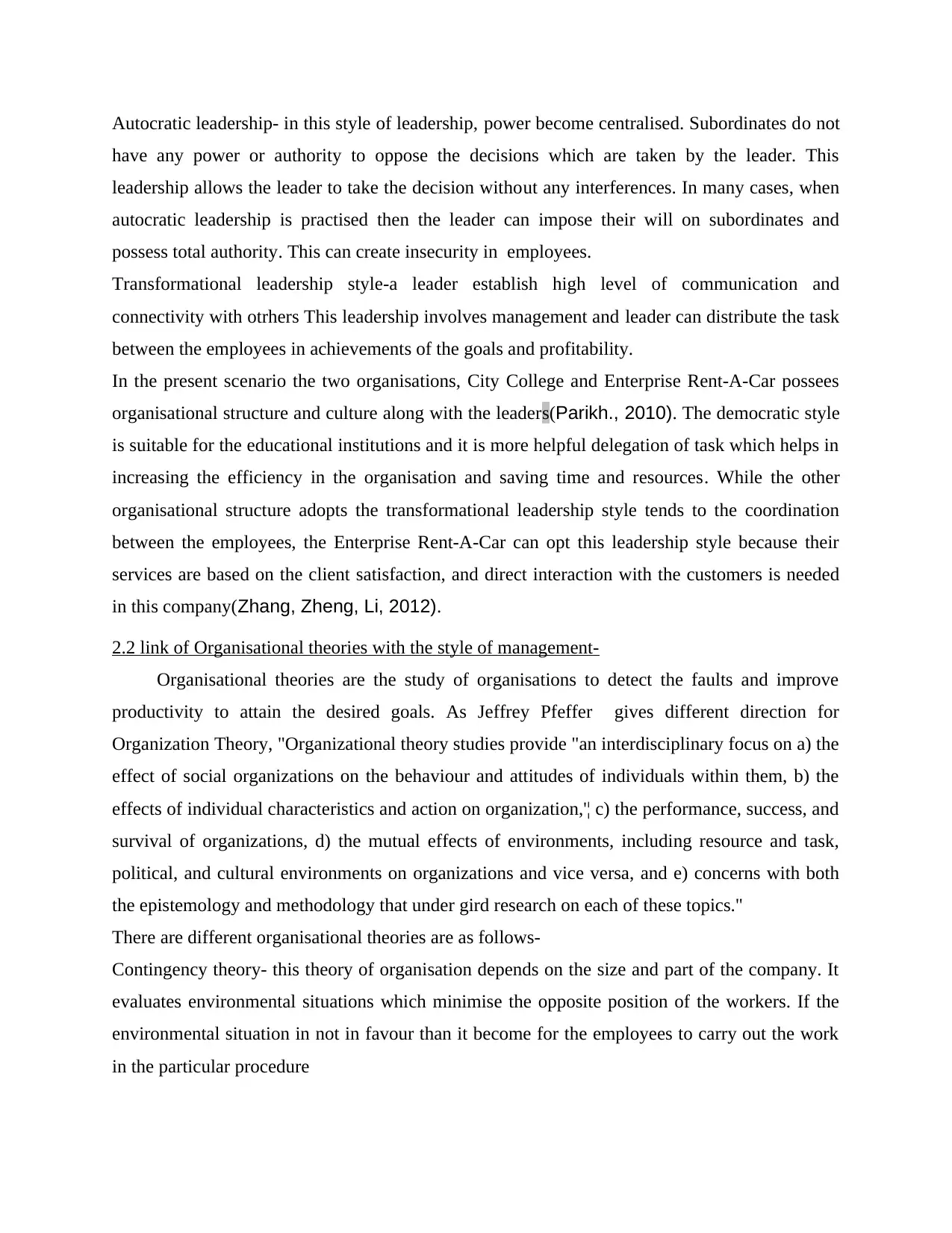
Autocratic leadership- in this style of leadership, power become centralised. Subordinates do not
have any power or authority to oppose the decisions which are taken by the leader. This
leadership allows the leader to take the decision without any interferences. In many cases, when
autocratic leadership is practised then the leader can impose their will on subordinates and
possess total authority. This can create insecurity in employees.
Transformational leadership style-a leader establish high level of communication and
connectivity with otrhers This leadership involves management and leader can distribute the task
between the employees in achievements of the goals and profitability.
In the present scenario the two organisations, City College and Enterprise Rent-A-Car possees
organisational structure and culture along with the leaders(Parikh., 2010). The democratic style
is suitable for the educational institutions and it is more helpful delegation of task which helps in
increasing the efficiency in the organisation and saving time and resources. While the other
organisational structure adopts the transformational leadership style tends to the coordination
between the employees, the Enterprise Rent-A-Car can opt this leadership style because their
services are based on the client satisfaction, and direct interaction with the customers is needed
in this company(Zhang, Zheng, Li, 2012).
2.2 link of Organisational theories with the style of management-
Organisational theories are the study of organisations to detect the faults and improve
productivity to attain the desired goals. As Jeffrey Pfeffer gives different direction for
Organization Theory, "Organizational theory studies provide "an interdisciplinary focus on a) the
effect of social organizations on the behaviour and attitudes of individuals within them, b) the
effects of individual characteristics and action on organization,'¦ c) the performance, success, and
survival of organizations, d) the mutual effects of environments, including resource and task,
political, and cultural environments on organizations and vice versa, and e) concerns with both
the epistemology and methodology that under gird research on each of these topics."
There are different organisational theories are as follows-
Contingency theory- this theory of organisation depends on the size and part of the company. It
evaluates environmental situations which minimise the opposite position of the workers. If the
environmental situation in not in favour than it become for the employees to carry out the work
in the particular procedure
have any power or authority to oppose the decisions which are taken by the leader. This
leadership allows the leader to take the decision without any interferences. In many cases, when
autocratic leadership is practised then the leader can impose their will on subordinates and
possess total authority. This can create insecurity in employees.
Transformational leadership style-a leader establish high level of communication and
connectivity with otrhers This leadership involves management and leader can distribute the task
between the employees in achievements of the goals and profitability.
In the present scenario the two organisations, City College and Enterprise Rent-A-Car possees
organisational structure and culture along with the leaders(Parikh., 2010). The democratic style
is suitable for the educational institutions and it is more helpful delegation of task which helps in
increasing the efficiency in the organisation and saving time and resources. While the other
organisational structure adopts the transformational leadership style tends to the coordination
between the employees, the Enterprise Rent-A-Car can opt this leadership style because their
services are based on the client satisfaction, and direct interaction with the customers is needed
in this company(Zhang, Zheng, Li, 2012).
2.2 link of Organisational theories with the style of management-
Organisational theories are the study of organisations to detect the faults and improve
productivity to attain the desired goals. As Jeffrey Pfeffer gives different direction for
Organization Theory, "Organizational theory studies provide "an interdisciplinary focus on a) the
effect of social organizations on the behaviour and attitudes of individuals within them, b) the
effects of individual characteristics and action on organization,'¦ c) the performance, success, and
survival of organizations, d) the mutual effects of environments, including resource and task,
political, and cultural environments on organizations and vice versa, and e) concerns with both
the epistemology and methodology that under gird research on each of these topics."
There are different organisational theories are as follows-
Contingency theory- this theory of organisation depends on the size and part of the company. It
evaluates environmental situations which minimise the opposite position of the workers. If the
environmental situation in not in favour than it become for the employees to carry out the work
in the particular procedure
Paraphrase This Document
Need a fresh take? Get an instant paraphrase of this document with our AI Paraphraser
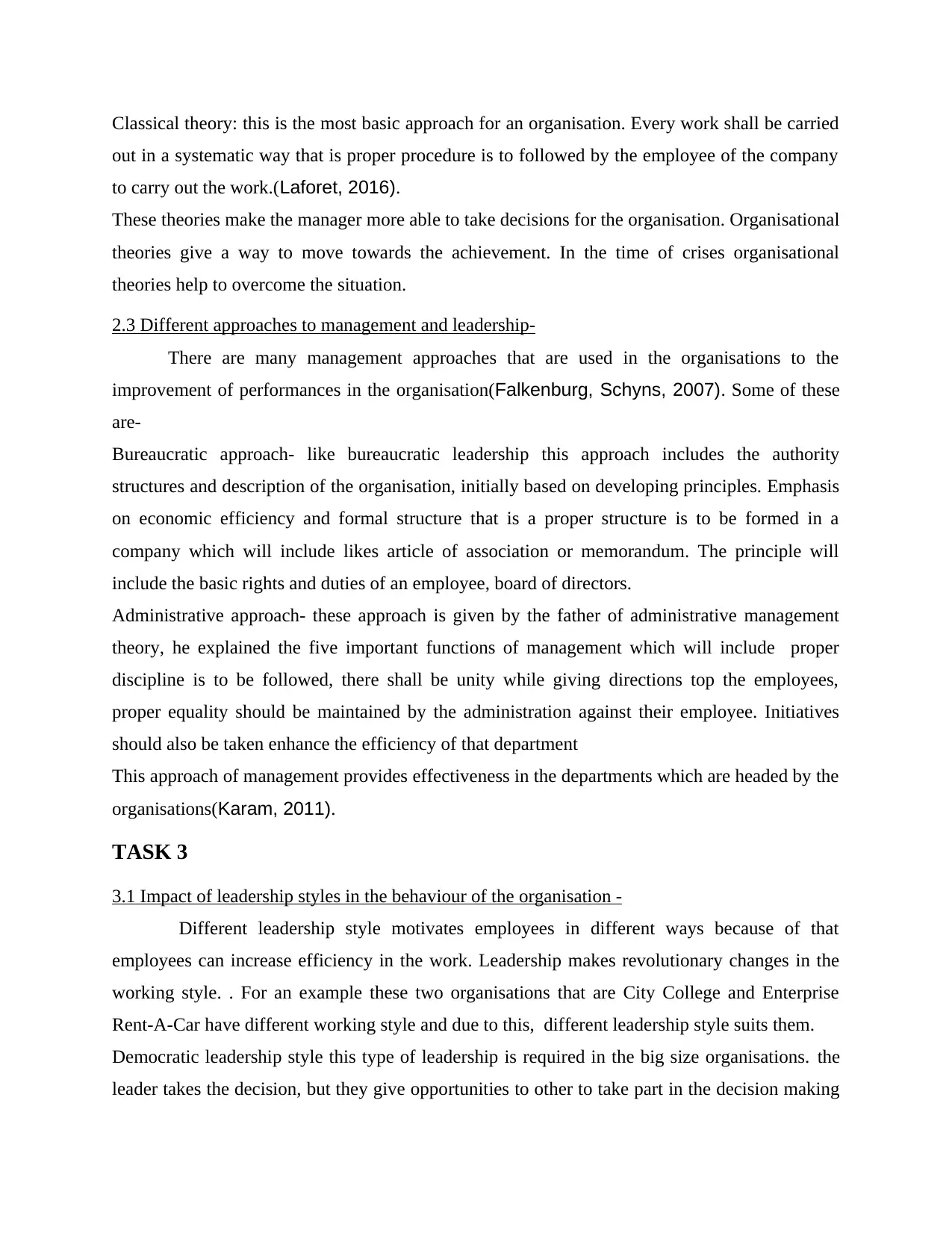
Classical theory: this is the most basic approach for an organisation. Every work shall be carried
out in a systematic way that is proper procedure is to followed by the employee of the company
to carry out the work.(Laforet, 2016).
These theories make the manager more able to take decisions for the organisation. Organisational
theories give a way to move towards the achievement. In the time of crises organisational
theories help to overcome the situation.
2.3 Different approaches to management and leadership-
There are many management approaches that are used in the organisations to the
improvement of performances in the organisation(Falkenburg, Schyns, 2007). Some of these
are-
Bureaucratic approach- like bureaucratic leadership this approach includes the authority
structures and description of the organisation, initially based on developing principles. Emphasis
on economic efficiency and formal structure that is a proper structure is to be formed in a
company which will include likes article of association or memorandum. The principle will
include the basic rights and duties of an employee, board of directors.
Administrative approach- these approach is given by the father of administrative management
theory, he explained the five important functions of management which will include proper
discipline is to be followed, there shall be unity while giving directions top the employees,
proper equality should be maintained by the administration against their employee. Initiatives
should also be taken enhance the efficiency of that department
This approach of management provides effectiveness in the departments which are headed by the
organisations(Karam, 2011).
TASK 3
3.1 Impact of leadership styles in the behaviour of the organisation -
Different leadership style motivates employees in different ways because of that
employees can increase efficiency in the work. Leadership makes revolutionary changes in the
working style. . For an example these two organisations that are City College and Enterprise
Rent-A-Car have different working style and due to this, different leadership style suits them.
Democratic leadership style this type of leadership is required in the big size organisations. the
leader takes the decision, but they give opportunities to other to take part in the decision making
out in a systematic way that is proper procedure is to followed by the employee of the company
to carry out the work.(Laforet, 2016).
These theories make the manager more able to take decisions for the organisation. Organisational
theories give a way to move towards the achievement. In the time of crises organisational
theories help to overcome the situation.
2.3 Different approaches to management and leadership-
There are many management approaches that are used in the organisations to the
improvement of performances in the organisation(Falkenburg, Schyns, 2007). Some of these
are-
Bureaucratic approach- like bureaucratic leadership this approach includes the authority
structures and description of the organisation, initially based on developing principles. Emphasis
on economic efficiency and formal structure that is a proper structure is to be formed in a
company which will include likes article of association or memorandum. The principle will
include the basic rights and duties of an employee, board of directors.
Administrative approach- these approach is given by the father of administrative management
theory, he explained the five important functions of management which will include proper
discipline is to be followed, there shall be unity while giving directions top the employees,
proper equality should be maintained by the administration against their employee. Initiatives
should also be taken enhance the efficiency of that department
This approach of management provides effectiveness in the departments which are headed by the
organisations(Karam, 2011).
TASK 3
3.1 Impact of leadership styles in the behaviour of the organisation -
Different leadership style motivates employees in different ways because of that
employees can increase efficiency in the work. Leadership makes revolutionary changes in the
working style. . For an example these two organisations that are City College and Enterprise
Rent-A-Car have different working style and due to this, different leadership style suits them.
Democratic leadership style this type of leadership is required in the big size organisations. the
leader takes the decision, but they give opportunities to other to take part in the decision making
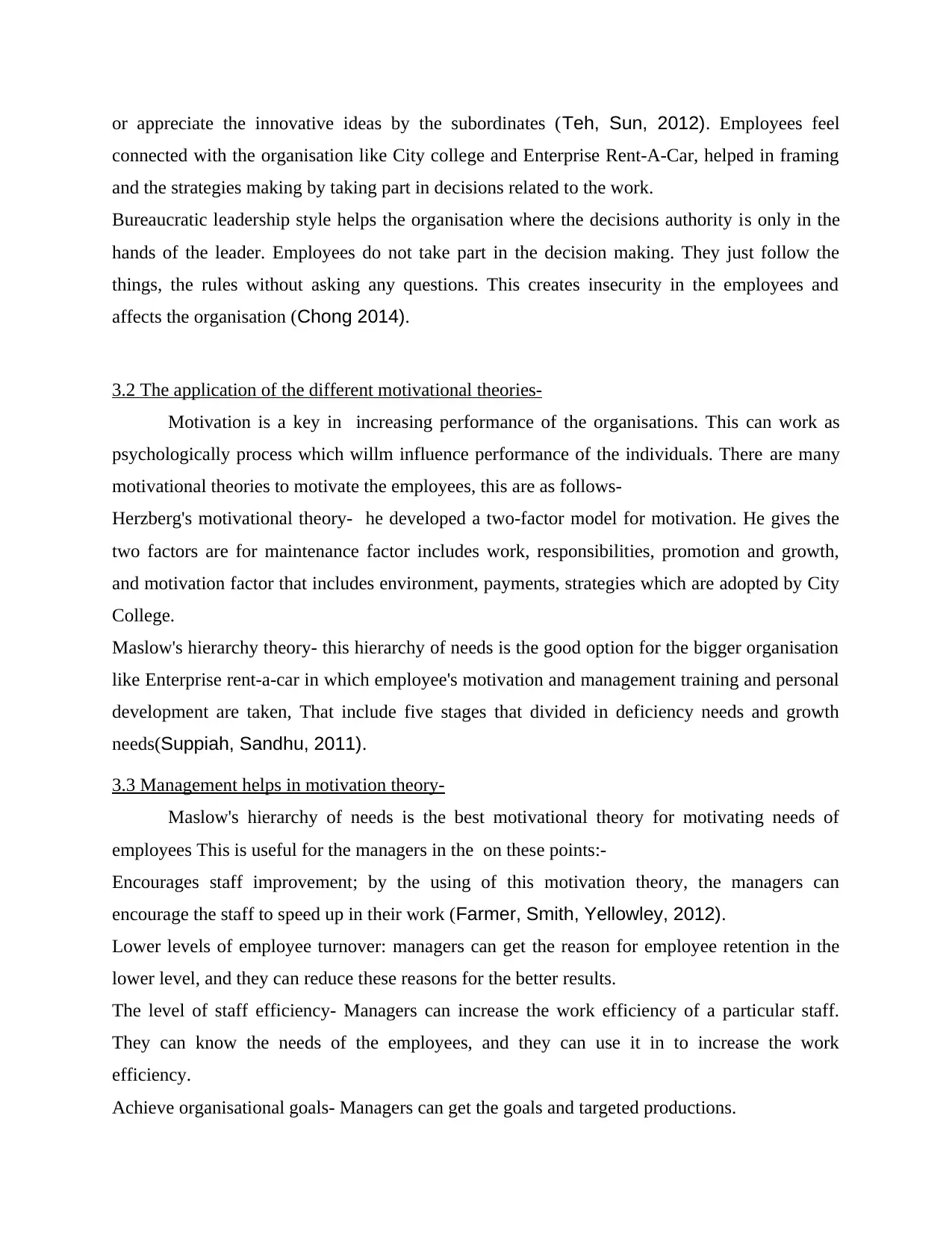
or appreciate the innovative ideas by the subordinates (Teh, Sun, 2012). Employees feel
connected with the organisation like City college and Enterprise Rent-A-Car, helped in framing
and the strategies making by taking part in decisions related to the work.
Bureaucratic leadership style helps the organisation where the decisions authority is only in the
hands of the leader. Employees do not take part in the decision making. They just follow the
things, the rules without asking any questions. This creates insecurity in the employees and
affects the organisation (Chong 2014).
3.2 The application of the different motivational theories-
Motivation is a key in increasing performance of the organisations. This can work as
psychologically process which willm influence performance of the individuals. There are many
motivational theories to motivate the employees, this are as follows-
Herzberg's motivational theory- he developed a two-factor model for motivation. He gives the
two factors are for maintenance factor includes work, responsibilities, promotion and growth,
and motivation factor that includes environment, payments, strategies which are adopted by City
College.
Maslow's hierarchy theory- this hierarchy of needs is the good option for the bigger organisation
like Enterprise rent-a-car in which employee's motivation and management training and personal
development are taken, That include five stages that divided in deficiency needs and growth
needs(Suppiah, Sandhu, 2011).
3.3 Management helps in motivation theory-
Maslow's hierarchy of needs is the best motivational theory for motivating needs of
employees This is useful for the managers in the on these points:-
Encourages staff improvement; by the using of this motivation theory, the managers can
encourage the staff to speed up in their work (Farmer, Smith, Yellowley, 2012).
Lower levels of employee turnover: managers can get the reason for employee retention in the
lower level, and they can reduce these reasons for the better results.
The level of staff efficiency- Managers can increase the work efficiency of a particular staff.
They can know the needs of the employees, and they can use it in to increase the work
efficiency.
Achieve organisational goals- Managers can get the goals and targeted productions.
connected with the organisation like City college and Enterprise Rent-A-Car, helped in framing
and the strategies making by taking part in decisions related to the work.
Bureaucratic leadership style helps the organisation where the decisions authority is only in the
hands of the leader. Employees do not take part in the decision making. They just follow the
things, the rules without asking any questions. This creates insecurity in the employees and
affects the organisation (Chong 2014).
3.2 The application of the different motivational theories-
Motivation is a key in increasing performance of the organisations. This can work as
psychologically process which willm influence performance of the individuals. There are many
motivational theories to motivate the employees, this are as follows-
Herzberg's motivational theory- he developed a two-factor model for motivation. He gives the
two factors are for maintenance factor includes work, responsibilities, promotion and growth,
and motivation factor that includes environment, payments, strategies which are adopted by City
College.
Maslow's hierarchy theory- this hierarchy of needs is the good option for the bigger organisation
like Enterprise rent-a-car in which employee's motivation and management training and personal
development are taken, That include five stages that divided in deficiency needs and growth
needs(Suppiah, Sandhu, 2011).
3.3 Management helps in motivation theory-
Maslow's hierarchy of needs is the best motivational theory for motivating needs of
employees This is useful for the managers in the on these points:-
Encourages staff improvement; by the using of this motivation theory, the managers can
encourage the staff to speed up in their work (Farmer, Smith, Yellowley, 2012).
Lower levels of employee turnover: managers can get the reason for employee retention in the
lower level, and they can reduce these reasons for the better results.
The level of staff efficiency- Managers can increase the work efficiency of a particular staff.
They can know the needs of the employees, and they can use it in to increase the work
efficiency.
Achieve organisational goals- Managers can get the goals and targeted productions.
⊘ This is a preview!⊘
Do you want full access?
Subscribe today to unlock all pages.

Trusted by 1+ million students worldwide
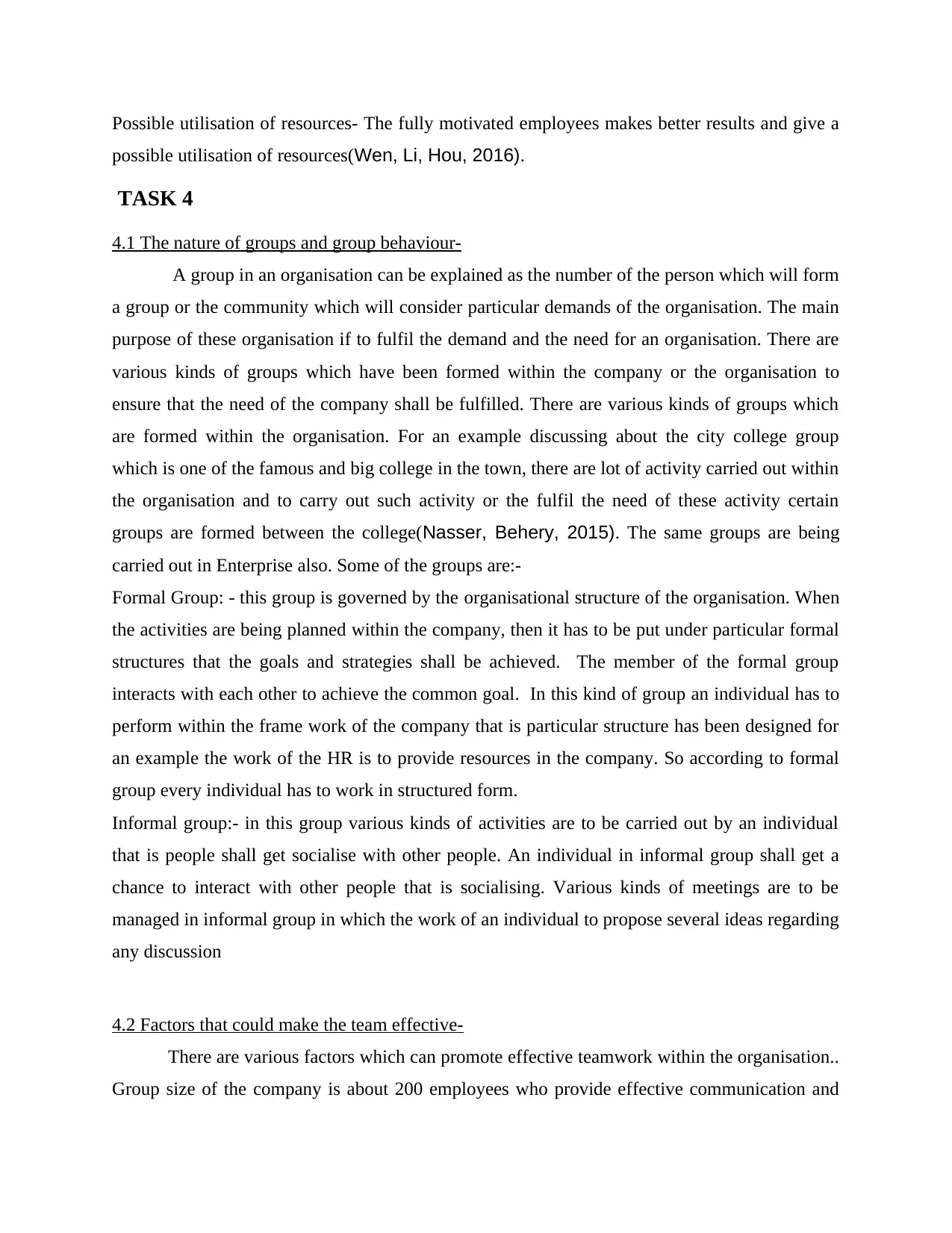
Possible utilisation of resources- The fully motivated employees makes better results and give a
possible utilisation of resources(Wen, Li, Hou, 2016).
TASK 4
4.1 The nature of groups and group behaviour-
A group in an organisation can be explained as the number of the person which will form
a group or the community which will consider particular demands of the organisation. The main
purpose of these organisation if to fulfil the demand and the need for an organisation. There are
various kinds of groups which have been formed within the company or the organisation to
ensure that the need of the company shall be fulfilled. There are various kinds of groups which
are formed within the organisation. For an example discussing about the city college group
which is one of the famous and big college in the town, there are lot of activity carried out within
the organisation and to carry out such activity or the fulfil the need of these activity certain
groups are formed between the college(Nasser, Behery, 2015). The same groups are being
carried out in Enterprise also. Some of the groups are:-
Formal Group: - this group is governed by the organisational structure of the organisation. When
the activities are being planned within the company, then it has to be put under particular formal
structures that the goals and strategies shall be achieved. The member of the formal group
interacts with each other to achieve the common goal. In this kind of group an individual has to
perform within the frame work of the company that is particular structure has been designed for
an example the work of the HR is to provide resources in the company. So according to formal
group every individual has to work in structured form.
Informal group:- in this group various kinds of activities are to be carried out by an individual
that is people shall get socialise with other people. An individual in informal group shall get a
chance to interact with other people that is socialising. Various kinds of meetings are to be
managed in informal group in which the work of an individual to propose several ideas regarding
any discussion
4.2 Factors that could make the team effective-
There are various factors which can promote effective teamwork within the organisation..
Group size of the company is about 200 employees who provide effective communication and
possible utilisation of resources(Wen, Li, Hou, 2016).
TASK 4
4.1 The nature of groups and group behaviour-
A group in an organisation can be explained as the number of the person which will form
a group or the community which will consider particular demands of the organisation. The main
purpose of these organisation if to fulfil the demand and the need for an organisation. There are
various kinds of groups which have been formed within the company or the organisation to
ensure that the need of the company shall be fulfilled. There are various kinds of groups which
are formed within the organisation. For an example discussing about the city college group
which is one of the famous and big college in the town, there are lot of activity carried out within
the organisation and to carry out such activity or the fulfil the need of these activity certain
groups are formed between the college(Nasser, Behery, 2015). The same groups are being
carried out in Enterprise also. Some of the groups are:-
Formal Group: - this group is governed by the organisational structure of the organisation. When
the activities are being planned within the company, then it has to be put under particular formal
structures that the goals and strategies shall be achieved. The member of the formal group
interacts with each other to achieve the common goal. In this kind of group an individual has to
perform within the frame work of the company that is particular structure has been designed for
an example the work of the HR is to provide resources in the company. So according to formal
group every individual has to work in structured form.
Informal group:- in this group various kinds of activities are to be carried out by an individual
that is people shall get socialise with other people. An individual in informal group shall get a
chance to interact with other people that is socialising. Various kinds of meetings are to be
managed in informal group in which the work of an individual to propose several ideas regarding
any discussion
4.2 Factors that could make the team effective-
There are various factors which can promote effective teamwork within the organisation..
Group size of the company is about 200 employees who provide effective communication and
Paraphrase This Document
Need a fresh take? Get an instant paraphrase of this document with our AI Paraphraser
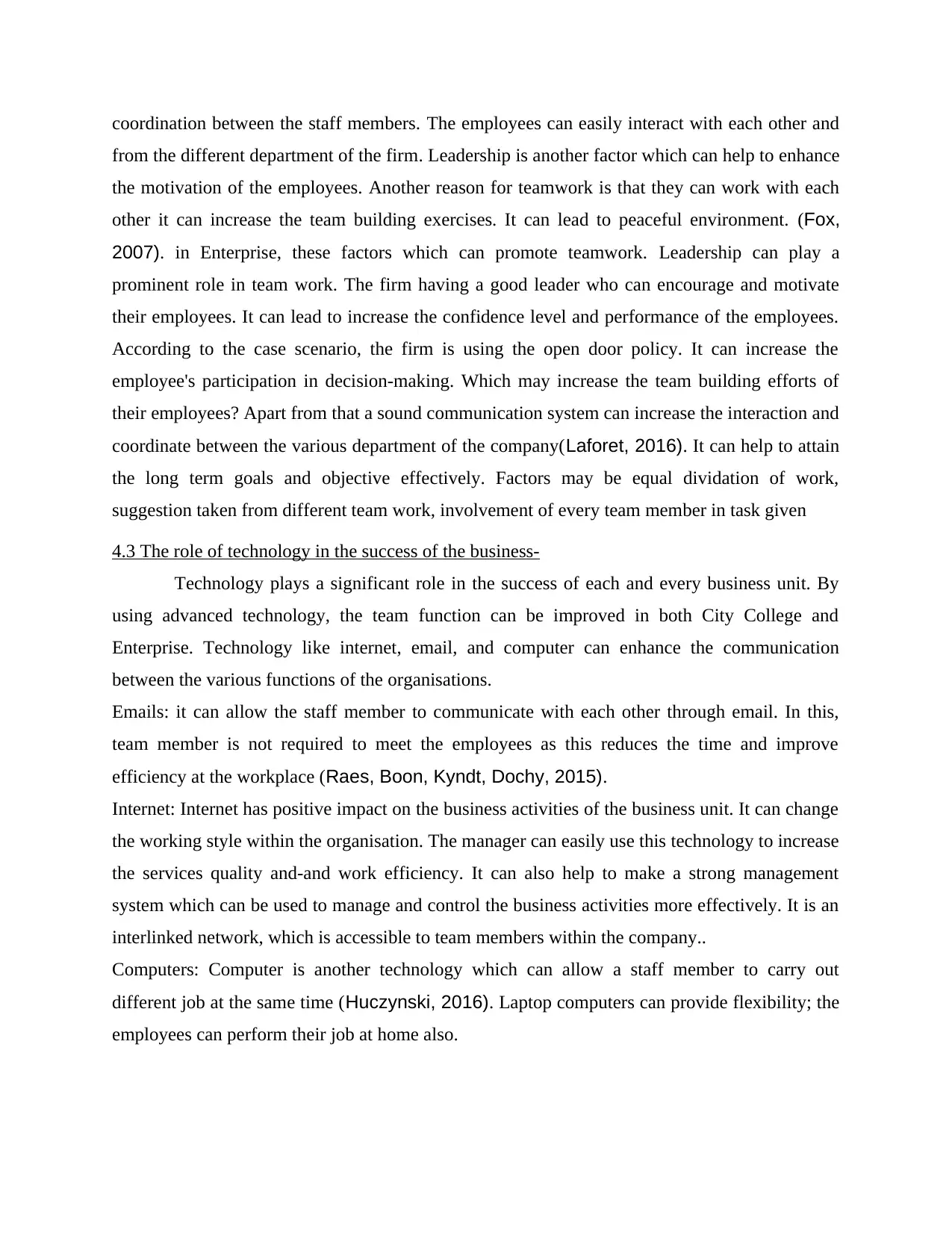
coordination between the staff members. The employees can easily interact with each other and
from the different department of the firm. Leadership is another factor which can help to enhance
the motivation of the employees. Another reason for teamwork is that they can work with each
other it can increase the team building exercises. It can lead to peaceful environment. (Fox,
2007). in Enterprise, these factors which can promote teamwork. Leadership can play a
prominent role in team work. The firm having a good leader who can encourage and motivate
their employees. It can lead to increase the confidence level and performance of the employees.
According to the case scenario, the firm is using the open door policy. It can increase the
employee's participation in decision-making. Which may increase the team building efforts of
their employees? Apart from that a sound communication system can increase the interaction and
coordinate between the various department of the company(Laforet, 2016). It can help to attain
the long term goals and objective effectively. Factors may be equal dividation of work,
suggestion taken from different team work, involvement of every team member in task given
4.3 The role of technology in the success of the business-
Technology plays a significant role in the success of each and every business unit. By
using advanced technology, the team function can be improved in both City College and
Enterprise. Technology like internet, email, and computer can enhance the communication
between the various functions of the organisations.
Emails: it can allow the staff member to communicate with each other through email. In this,
team member is not required to meet the employees as this reduces the time and improve
efficiency at the workplace (Raes, Boon, Kyndt, Dochy, 2015).
Internet: Internet has positive impact on the business activities of the business unit. It can change
the working style within the organisation. The manager can easily use this technology to increase
the services quality and-and work efficiency. It can also help to make a strong management
system which can be used to manage and control the business activities more effectively. It is an
interlinked network, which is accessible to team members within the company..
Computers: Computer is another technology which can allow a staff member to carry out
different job at the same time (Huczynski, 2016). Laptop computers can provide flexibility; the
employees can perform their job at home also.
from the different department of the firm. Leadership is another factor which can help to enhance
the motivation of the employees. Another reason for teamwork is that they can work with each
other it can increase the team building exercises. It can lead to peaceful environment. (Fox,
2007). in Enterprise, these factors which can promote teamwork. Leadership can play a
prominent role in team work. The firm having a good leader who can encourage and motivate
their employees. It can lead to increase the confidence level and performance of the employees.
According to the case scenario, the firm is using the open door policy. It can increase the
employee's participation in decision-making. Which may increase the team building efforts of
their employees? Apart from that a sound communication system can increase the interaction and
coordinate between the various department of the company(Laforet, 2016). It can help to attain
the long term goals and objective effectively. Factors may be equal dividation of work,
suggestion taken from different team work, involvement of every team member in task given
4.3 The role of technology in the success of the business-
Technology plays a significant role in the success of each and every business unit. By
using advanced technology, the team function can be improved in both City College and
Enterprise. Technology like internet, email, and computer can enhance the communication
between the various functions of the organisations.
Emails: it can allow the staff member to communicate with each other through email. In this,
team member is not required to meet the employees as this reduces the time and improve
efficiency at the workplace (Raes, Boon, Kyndt, Dochy, 2015).
Internet: Internet has positive impact on the business activities of the business unit. It can change
the working style within the organisation. The manager can easily use this technology to increase
the services quality and-and work efficiency. It can also help to make a strong management
system which can be used to manage and control the business activities more effectively. It is an
interlinked network, which is accessible to team members within the company..
Computers: Computer is another technology which can allow a staff member to carry out
different job at the same time (Huczynski, 2016). Laptop computers can provide flexibility; the
employees can perform their job at home also.
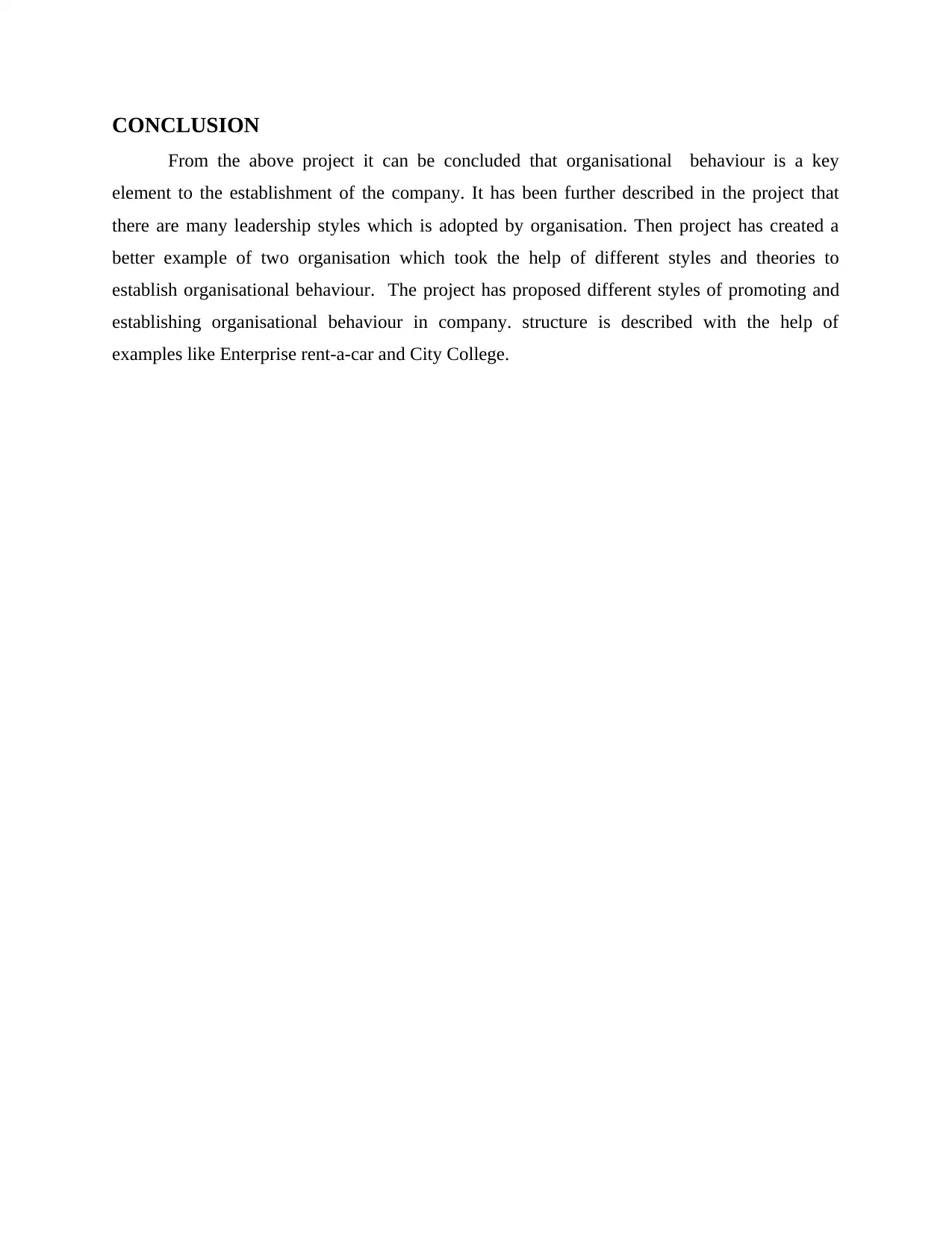
CONCLUSION
From the above project it can be concluded that organisational behaviour is a key
element to the establishment of the company. It has been further described in the project that
there are many leadership styles which is adopted by organisation. Then project has created a
better example of two organisation which took the help of different styles and theories to
establish organisational behaviour. The project has proposed different styles of promoting and
establishing organisational behaviour in company. structure is described with the help of
examples like Enterprise rent-a-car and City College.
From the above project it can be concluded that organisational behaviour is a key
element to the establishment of the company. It has been further described in the project that
there are many leadership styles which is adopted by organisation. Then project has created a
better example of two organisation which took the help of different styles and theories to
establish organisational behaviour. The project has proposed different styles of promoting and
establishing organisational behaviour in company. structure is described with the help of
examples like Enterprise rent-a-car and City College.
⊘ This is a preview!⊘
Do you want full access?
Subscribe today to unlock all pages.

Trusted by 1+ million students worldwide
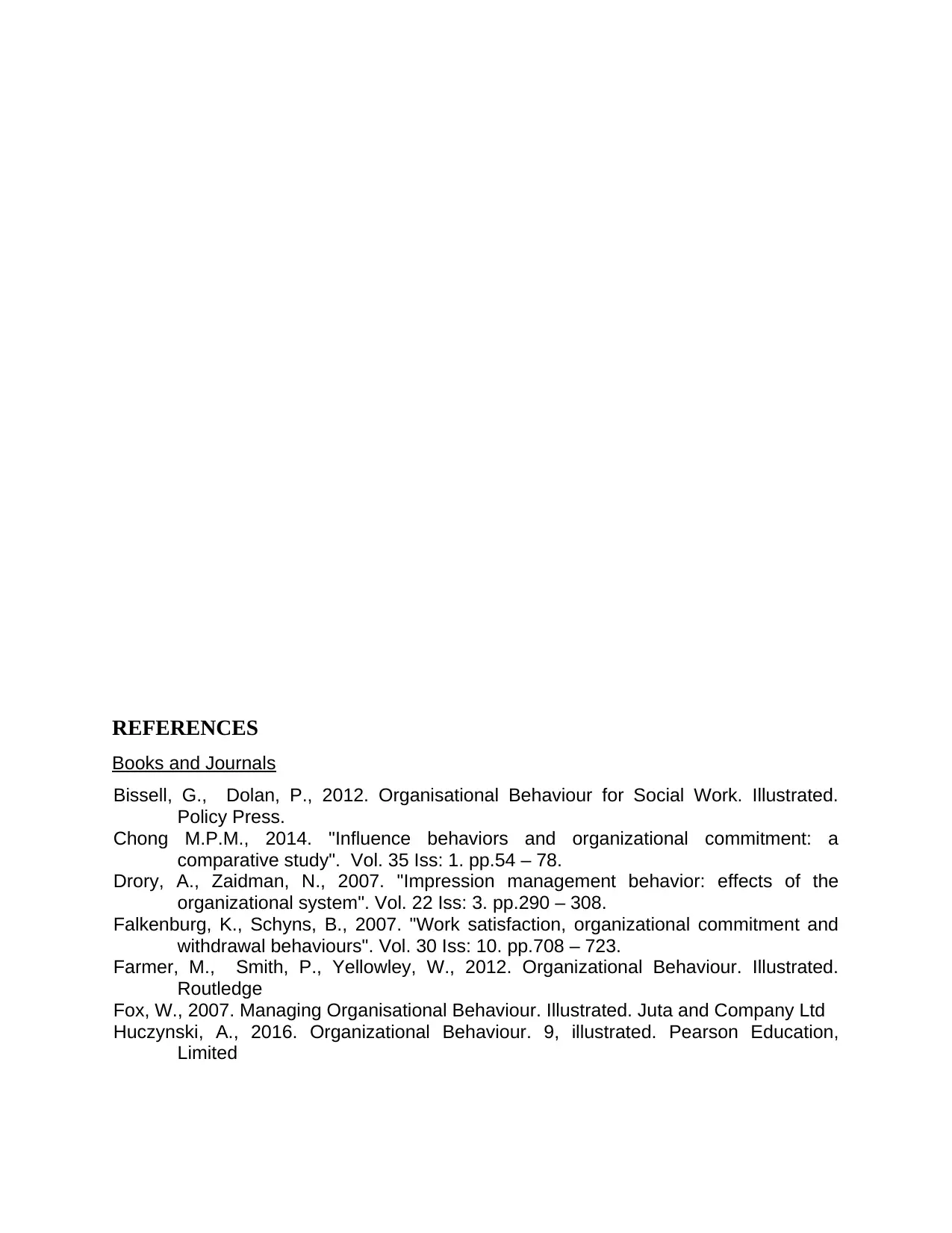
REFERENCES
Books and Journals
Bissell, G., Dolan, P., 2012. Organisational Behaviour for Social Work. Illustrated.
Policy Press.
Chong M.P.M., 2014. "Influence behaviors and organizational commitment: a
comparative study". Vol. 35 Iss: 1. pp.54 – 78.
Drory, A., Zaidman, N., 2007. "Impression management behavior: effects of the
organizational system". Vol. 22 Iss: 3. pp.290 – 308.
Falkenburg, K., Schyns, B., 2007. "Work satisfaction, organizational commitment and
withdrawal behaviours". Vol. 30 Iss: 10. pp.708 – 723.
Farmer, M., Smith, P., Yellowley, W., 2012. Organizational Behaviour. Illustrated.
Routledge
Fox, W., 2007. Managing Organisational Behaviour. Illustrated. Juta and Company Ltd
Huczynski, A., 2016. Organizational Behaviour. 9, illustrated. Pearson Education,
Limited
Books and Journals
Bissell, G., Dolan, P., 2012. Organisational Behaviour for Social Work. Illustrated.
Policy Press.
Chong M.P.M., 2014. "Influence behaviors and organizational commitment: a
comparative study". Vol. 35 Iss: 1. pp.54 – 78.
Drory, A., Zaidman, N., 2007. "Impression management behavior: effects of the
organizational system". Vol. 22 Iss: 3. pp.290 – 308.
Falkenburg, K., Schyns, B., 2007. "Work satisfaction, organizational commitment and
withdrawal behaviours". Vol. 30 Iss: 10. pp.708 – 723.
Farmer, M., Smith, P., Yellowley, W., 2012. Organizational Behaviour. Illustrated.
Routledge
Fox, W., 2007. Managing Organisational Behaviour. Illustrated. Juta and Company Ltd
Huczynski, A., 2016. Organizational Behaviour. 9, illustrated. Pearson Education,
Limited
Paraphrase This Document
Need a fresh take? Get an instant paraphrase of this document with our AI Paraphraser
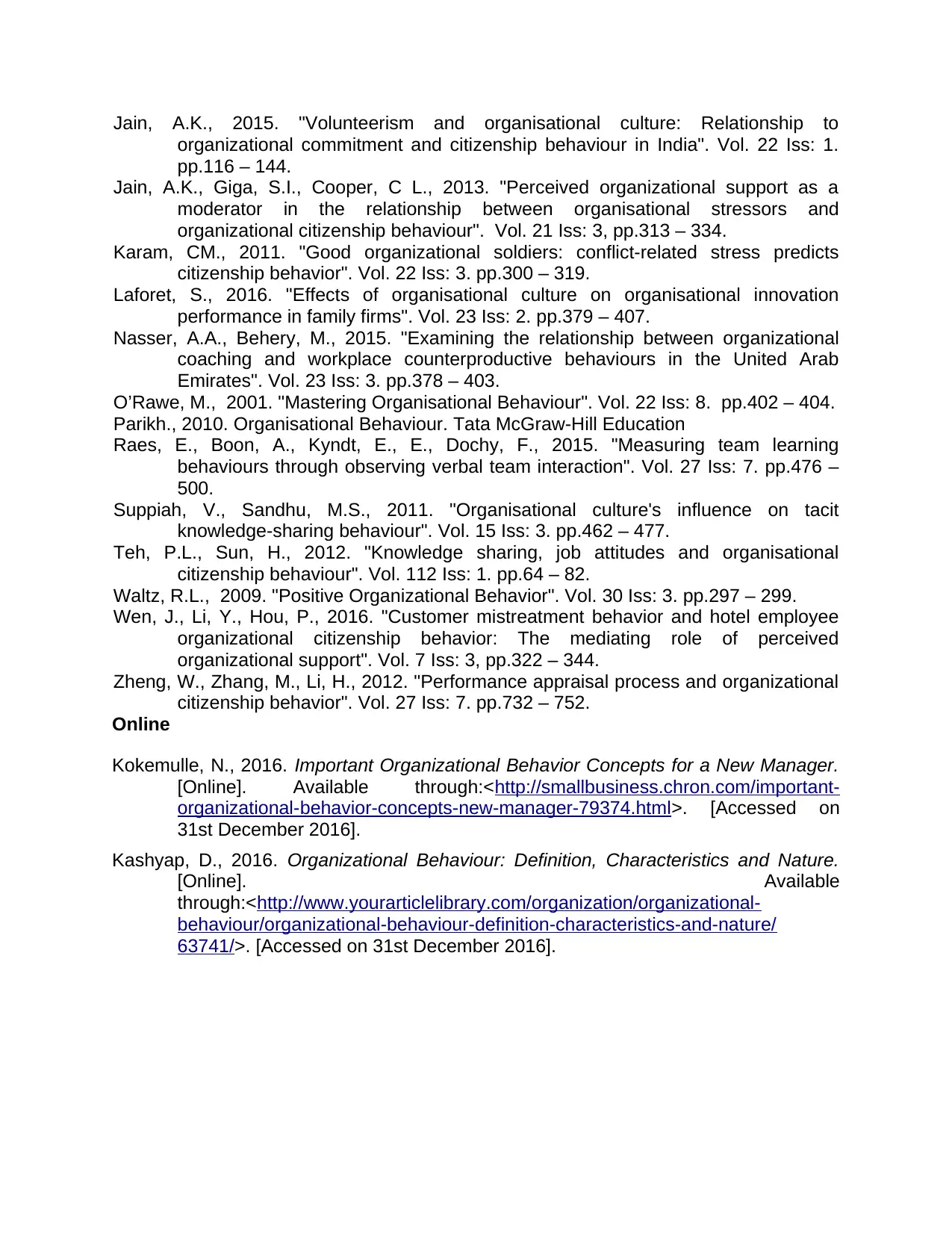
Jain, A.K., 2015. "Volunteerism and organisational culture: Relationship to
organizational commitment and citizenship behaviour in India". Vol. 22 Iss: 1.
pp.116 – 144.
Jain, A.K., Giga, S.I., Cooper, C L., 2013. "Perceived organizational support as a
moderator in the relationship between organisational stressors and
organizational citizenship behaviour". Vol. 21 Iss: 3, pp.313 – 334.
Karam, CM., 2011. "Good organizational soldiers: conflict‐related stress predicts
citizenship behavior". Vol. 22 Iss: 3. pp.300 – 319.
Laforet, S., 2016. "Effects of organisational culture on organisational innovation
performance in family firms". Vol. 23 Iss: 2. pp.379 – 407.
Nasser, A.A., Behery, M., 2015. "Examining the relationship between organizational
coaching and workplace counterproductive behaviours in the United Arab
Emirates". Vol. 23 Iss: 3. pp.378 – 403.
O’Rawe, M., 2001. "Mastering Organisational Behaviour". Vol. 22 Iss: 8. pp.402 – 404.
Parikh., 2010. Organisational Behaviour. Tata McGraw-Hill Education
Raes, E., Boon, A., Kyndt, E., E., Dochy, F., 2015. "Measuring team learning
behaviours through observing verbal team interaction". Vol. 27 Iss: 7. pp.476 –
500.
Suppiah, V., Sandhu, M.S., 2011. "Organisational culture's influence on tacit
knowledge‐sharing behaviour". Vol. 15 Iss: 3. pp.462 – 477.
Teh, P.L., Sun, H., 2012. "Knowledge sharing, job attitudes and organisational
citizenship behaviour". Vol. 112 Iss: 1. pp.64 – 82.
Waltz, R.L., 2009. "Positive Organizational Behavior". Vol. 30 Iss: 3. pp.297 – 299.
Wen, J., Li, Y., Hou, P., 2016. "Customer mistreatment behavior and hotel employee
organizational citizenship behavior: The mediating role of perceived
organizational support". Vol. 7 Iss: 3, pp.322 – 344.
Zheng, W., Zhang, M., Li, H., 2012. "Performance appraisal process and organizational
citizenship behavior". Vol. 27 Iss: 7. pp.732 – 752.
Online
Kokemulle, N., 2016. Important Organizational Behavior Concepts for a New Manager.
[Online]. Available through:<http://smallbusiness.chron.com/important-
organizational-behavior-concepts-new-manager-79374.html>. [Accessed on
31st December 2016].
Kashyap, D., 2016. Organizational Behaviour: Definition, Characteristics and Nature.
[Online]. Available
through:<http://www.yourarticlelibrary.com/organization/organizational-
behaviour/organizational-behaviour-definition-characteristics-and-nature/
63741/>. [Accessed on 31st December 2016].
organizational commitment and citizenship behaviour in India". Vol. 22 Iss: 1.
pp.116 – 144.
Jain, A.K., Giga, S.I., Cooper, C L., 2013. "Perceived organizational support as a
moderator in the relationship between organisational stressors and
organizational citizenship behaviour". Vol. 21 Iss: 3, pp.313 – 334.
Karam, CM., 2011. "Good organizational soldiers: conflict‐related stress predicts
citizenship behavior". Vol. 22 Iss: 3. pp.300 – 319.
Laforet, S., 2016. "Effects of organisational culture on organisational innovation
performance in family firms". Vol. 23 Iss: 2. pp.379 – 407.
Nasser, A.A., Behery, M., 2015. "Examining the relationship between organizational
coaching and workplace counterproductive behaviours in the United Arab
Emirates". Vol. 23 Iss: 3. pp.378 – 403.
O’Rawe, M., 2001. "Mastering Organisational Behaviour". Vol. 22 Iss: 8. pp.402 – 404.
Parikh., 2010. Organisational Behaviour. Tata McGraw-Hill Education
Raes, E., Boon, A., Kyndt, E., E., Dochy, F., 2015. "Measuring team learning
behaviours through observing verbal team interaction". Vol. 27 Iss: 7. pp.476 –
500.
Suppiah, V., Sandhu, M.S., 2011. "Organisational culture's influence on tacit
knowledge‐sharing behaviour". Vol. 15 Iss: 3. pp.462 – 477.
Teh, P.L., Sun, H., 2012. "Knowledge sharing, job attitudes and organisational
citizenship behaviour". Vol. 112 Iss: 1. pp.64 – 82.
Waltz, R.L., 2009. "Positive Organizational Behavior". Vol. 30 Iss: 3. pp.297 – 299.
Wen, J., Li, Y., Hou, P., 2016. "Customer mistreatment behavior and hotel employee
organizational citizenship behavior: The mediating role of perceived
organizational support". Vol. 7 Iss: 3, pp.322 – 344.
Zheng, W., Zhang, M., Li, H., 2012. "Performance appraisal process and organizational
citizenship behavior". Vol. 27 Iss: 7. pp.732 – 752.
Online
Kokemulle, N., 2016. Important Organizational Behavior Concepts for a New Manager.
[Online]. Available through:<http://smallbusiness.chron.com/important-
organizational-behavior-concepts-new-manager-79374.html>. [Accessed on
31st December 2016].
Kashyap, D., 2016. Organizational Behaviour: Definition, Characteristics and Nature.
[Online]. Available
through:<http://www.yourarticlelibrary.com/organization/organizational-
behaviour/organizational-behaviour-definition-characteristics-and-nature/
63741/>. [Accessed on 31st December 2016].
1 out of 11
Related Documents
Your All-in-One AI-Powered Toolkit for Academic Success.
+13062052269
info@desklib.com
Available 24*7 on WhatsApp / Email
![[object Object]](/_next/static/media/star-bottom.7253800d.svg)
Unlock your academic potential
Copyright © 2020–2025 A2Z Services. All Rights Reserved. Developed and managed by ZUCOL.





